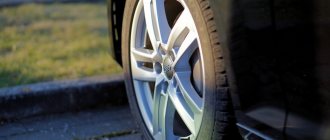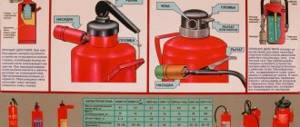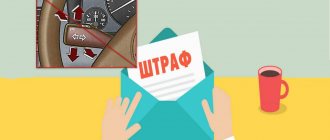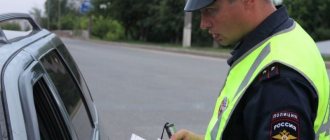In recent years, there have been regular conversations and rumors that Russia will soon introduce a fine for using winter tires in the summer and summer tires in the winter. They even named exact dates, and sometimes they even named the exact amount of a 2,000 ruble fine for summer tires on a winter road. First of all, we want to reassure all drivers at once - these fines for out-of-season tires have not been introduced in 2021, but Bill N 464241-6 “On Amendments to the Code of the Russian Federation on Administrative Offenses (to ensure safety during the operation of vehicles)” , which stipulated penalties for using summer tires in winter, was not adopted in the first reading.
But what kind of tires can a car owner be fined for if his vehicle runs on summer tires in winter and winter tires in summer? How to behave in a dialogue with a traffic police inspector in the event of a stop and inspection of the car’s wheels?
- Are there penalties for out-of-season tires in 2021?
- So what is the fine for summer tires in winter today?
- What penalties were offered for summer tires in winter?
- Is there a penalty for wearing winter tires in summer?
- What are the penalties for driving on bald tires in 2021?
- Will there be a ban on studded tires?
- Driving on all-season tires (Velcro) in 2021
- How can traffic police officers fine you for tires?
However, vehicle owners need to know the intricacies of the issue of regulating the legality of using one or another type of car tires in summer and winter, since it is possible that soon another bill will be approved in the State Duma and penalties will be introduced. In this article we will look at the problem in detail.
What types of fines are provided for driving with winter tires in summer?
Penalties for driving vehicles with winter tires in the summer were introduced in 2015. This was preceded by the signing in 2014 of the Technical Regulations “On the Safety of Wheeled Vehicles” of the Customs Union. According to this document, the operation of vehicles on studded tires is not permitted from June to August. For violation of requirements, the driver may be subject to administrative liability.
Types of liability for driving on winter tires in summer:
- if the rubber is of the “Velcro” type, when there are no spikes, then there is no fine at all;
- if winter tires are installed, but with studs, then you will have to pay 500 rubles;
- if there is a discrepancy in the tread height, the penalty will be 500 rubles.
Are there penalties for out-of-season tires?
Back in 2014, bill No. 464241-6 was introduced into the State Duma of the country, which proposed supplementing Article 12.5 of the Code of Administrative Offenses of the Russian Federation with part 3.2:
“Part 3.2 as follows: “3.2 Driving a vehicle in violation of the requirements for the operation of tires and wheels - entails the imposition of an administrative fine in the amount of two thousand rubles.”
For two years, consideration of this bill was postponed, but on October 20, 2021, it was sent for consideration to the State Duma and was to be considered in three readings. But in fact, the bill on a fine for using summer tires in winter did not even pass the first reading , and on November 1, 2021, it was decided to postpone its consideration indefinitely, and as of 2021, consideration of the “tire bill” was no longer started.
What do traffic rules say?
Section 5 of the Russian Government Decree No. 1090 dated October 23, 1993 lists the requirements for assessing the condition of wheels and tires.
These include:
- remaining tread depth;
- presence of external damage;
- missing or damaged fasteners;
- tires do not match the load;
- using rubber of different models, sizes, and tread patterns simultaneously.
If these parameters do not comply with established standards, the car owner will be fined.
What's the fine?
Here's some good news! Despite the direct ban on driving a vehicle with winter tires in the summer, there is no penalty for this in 2021: no fine, no operating ban, no other sanctions from the Administrative Code.
If a traffic police officer tries to deceive you, demand that you indicate a specific article of the Code of Administrative Offenses. In any case, it is indicated in the resolution and protocol - this obligation is regulated by the Administrative Code. And the Code of Administrative Offenses has an article - 12.5, part 1, which provides for a fine of 500 rubles for driving under conditions under which such driving is prohibited.
But this article has a direct reference to traffic rules, and the latter do not contain any prohibition. We have already mentioned above that such a ban is contained in the Technical Regulations.
What can a fine be issued for?
But there are other requirements for tires - specifically even for winter tires, because at the moment you are using them. We described in detail how winter and summer tires formally differ in another article about summer tires in winter. In short, this is the marking of a snowflake on a mountain with three peaks or the meaning of “M+S”, “M&S”, “MS”.
This is what she looks like:
That is, even if the tires are even studded, but there is no indicated marking, then formally you are not violating anything.
So, all requirements for winter tires, for which a fine may be issued, are regulated by the Traffic Regulations, specifically, Section 5 of the Main Faults (Appendix to the Traffic Regulations). Let's list them:
- tread depth of at least 4 mm (and it doesn’t matter that you use winter tires in the summer, a smaller residual depth is prohibited specifically for tires labeled as winter tires); but the requirement is relevant only if there are no wear indicators on the tires. If so, then, according to these indicators;
- There is damage on the tires in the form of:
- cuts, peeling, tears, if the cord is visible (it does not matter whether the cord threads are broken or not),
- separation of the tread from the “side”;
- if the tires do not correspond to the vehicle speed or load index;
- on one axle (front or rear) there are different tires, except for new and used ones (if they are not retreaded tires);
- studded tires are installed at the same time as non-studded tires.
If you do not comply with the above requirements, then a fine of 500 rubles becomes legal.
If the studs on studded tires come out
If all the studs on winter tires fall off, they do not become summer tires. The rubber compound of winter tires is designed for use in low temperatures. They have a different tread pattern for driving on snow and ice. And in rainy weather, winter tires do not drain water effectively enough, and the vehicle's stability on the road decreases. A hydroplaning effect occurs. But traffic police officers cannot issue a fine for driving on them in the summer, since only the use of tires with studs is prohibited.
How will fines for tires be collected?
The only way to determine whether tires are appropriate for the season is through a technical inspection. But, based on the law, new cars are exempt from maintenance. Old vehicles are inspected only once every 1 year.
If the amount of fines is determined by separate regulations, drivers will have to change the winter tires on their cars in a timely manner. Otherwise, each detention by traffic police officers will cost the vehicle owner 500 rubles (or more).
There are no fines for wearing winter tires, but driving a technically faulty car will result in appropriate punishment. In the future, the Government plans to tighten sanctions for the lack of seasonal wheels.
Tread height
Traffic regulations prohibit the use of bald tires and set the remaining tread depth for tire use in winter and summer. During the period from June to August, the tread of summer tires should be at least 1.6 mm deep. On winter tires with appropriate markings, the tread depth should not be less than 4 mm. It doesn’t matter what time of year you drive it.
What penalties were offered for summer tires in winter?
As we said above, rumors that in the near future it will be prohibited at the legislative level to “shoe” a vehicle out of season have been circulating for a long time, and several bills were submitted to the State Duma for consideration, but for various reasons, none passed even the first reading. The essence of these tire bills was as follows:
- To be fined for driving a vehicle using tires that are not in accordance with the season (the driver must use winter tires in the cold months, or “change the car’s shoes” taking into account the average daily temperature.
- To be fined for driving a vehicle on winter tires with studs in the summer.
- Refusal of insurance payment in the event that during an accident the culprit’s vehicle was wearing tires that were not appropriate for the season.
But, as we see, so far all these legislative initiatives have not gone further than bills, and you still decide for yourself when to change tires from summer to winter and vice versa! There is no fine for summer tires in winter in the Russian Federation!
Why can't you drive on winter tires in summer?
Even without studs, winter tires have properties that greatly distinguish them from summer tires. Therefore, there are several important reasons for refusing to use them in the warm season:
- Rubber softens and loses strength.
- The braking distance increases.
- The spikes are destroyed.
- The road surface is damaged.
- The car is more difficult to drive.
- Fuel consumption increases.
Because of this, the likelihood of an accident increases. In addition, there are risks of refusal to reimburse insurance payments due to non-compliance with traffic rules.
Is it necessary to stick on the “Spikes” sign if the car has studded tires?
Yes need. This is the requirement of the Road Traffic Rules, namely the annex to them, which is called the Basic Provisions for the Admission of a Vehicle to Operation.
One of the paragraphs of these provisions contains all additional signs that must be installed on the car in certain situations (for example, if the car is driven by a novice driver, the car is carrying dangerous or large cargo, etc.), or that the driver can install according to at will (there are only two such stickers: “Disabled” and “Doctor”).
The “Spikes” sticker is required. It must be applied to the rear of the vehicle if it has studded tires.
It is curious that the requirement to stick the “Spikes” sign has existed in traffic regulations for decades, but this issue only became particularly relevant in the spring of 2021.
The fact is that then another clause appeared in the traffic rules. In another application, which is called the List of faults and conditions under which the operation of the vehicle is prohibited, a clause was added that included among such conditions the absence of any of the mandatory signs (“Spikes”, “Beginner driver”, “Dangerous cargo”, etc. .).
After the absence of the “Spikes” sign became a condition prohibiting the operation of a vehicle if it had studded tires installed, a fine for such a violation automatically appeared.
Photo: pixnio.com
When to change winter tires to summer tires
This is evidenced by the technical regulation of the Customs Union TR CU 018/2011 “On the safety of wheeled vehicles.” Paragraph 5.5 of Appendix 8 says the following:
- During the summer season (June, July, August) driving only on studded tires is prohibited for all vehicles.
- During the winter period (December, January, February), driving is only permitted with winter tires, studded or not. It is imperative that they have markings on them, meaning that these tires can be used in winter (“M+S”,”M&S”,”MS” and a design with a snowflake and a mountain). These requirements apply only to category B vehicles (M1 cars and N1 trucks). From November 11, 2021, these restrictions do not apply to other cars.
- Established service life cannot be reduced by legislative authority at any level (neither federal nor regional), but can be increased. This means that specifically in your region there may be a ban on driving on studded winter tires for the period from June to October. But no one can establish the same ban for a shorter period than specified in the regulations. Throughout Russia, driving with studded tires is prohibited from June to August.
To summarize the above, you can build a “schedule” for using tires in accordance with the seasons:
- The period for using summer tires (without the “M+S”,”M&S”,”MS” marking and without the snowflake and mountain design) is from March to November.
- The period for using winter studded tires (marked “M+S”,”M&S”,”MS” and with a snowflake and mountain design) is from October to May.
- The period of use of winter non-studded tires (marked “M+S”,”M&S”,”MS” and with a snowflake and mountain pattern) is unlimited.
Let's look at a table with periods of possible tire use throughout the year:
| Summer | Winter studded | Winter studless | |
| Winter (December - February) | + | + | |
| Spring (March - May) | + | + | + |
| Summer (June - August) | + | + | |
| Autumn (September - November) | + | + | + |
We recommend
“How to choose wipers: we understand the design and materials” Read more










